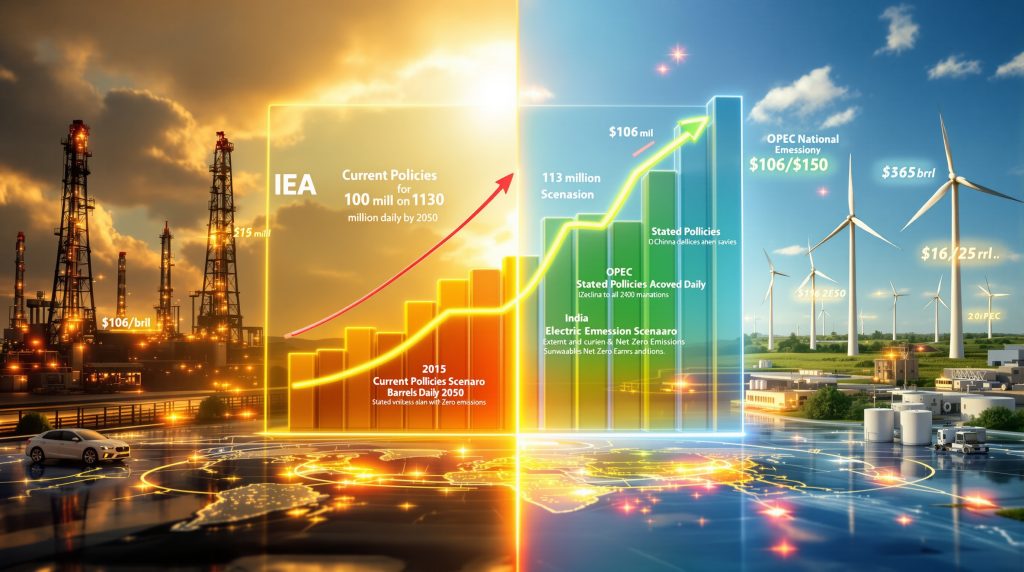Understanding the International Energy Agency's Strategic Shift
The International Energy Agency has fundamentally altered its energy forecasting methodology by reintroducing a scenario where global petroleum consumption continues expanding through 2050. This iea no peak oil scenario represents a dramatic departure from recent assessments that consistently projected demand plateaus occurring before 2030.
The agency's Current Policies Scenario, absent from World Energy Outlook reports between 2021-2023, has returned in the 2024 edition following post-pandemic market stabilisation and the resolution of acute geopolitical disruptions stemming from Russia's Ukraine invasion. This methodological shift acknowledges that energy transition timelines may extend beyond previously modelled assumptions, reflecting structural constraints in technology adoption and infrastructure development.
The IEA emphasises that this scenario functions as an analytical framework rather than a predictive forecast. Under current regulatory conditions without additional policy interventions, the framework explores potential outcomes where technological progress faces material limitations including infrastructure capacity constraints and capital availability barriers.
Why Has the IEA Revived the Current Policies Scenario?
The agency's decision to resurrect the Current Policies Scenario stems from recognition that existing regulatory frameworks may prove insufficient to drive rapid energy system transformation. Under this analytical framework, petroleum consumption would climb from 100 million barrels daily in 2024 to 113 million barrels by mid-century, assuming policy stagnation across major economies.
Key CPS Framework Assumptions:
- Infrastructure limitations constrain clean technology deployment rates
- Financing barriers slow renewable energy transitions across developing economies
- Existing regulations remain unchanged with no additional regulatory interventions
- Economic growth patterns continue along current trajectories without structural shifts
The scenario acknowledges that while certain technologies continue spreading under existing regulatory frameworks, structural barriers including weak infrastructure networks and inadequate financing mechanisms materially slow further technological progress. These constraints represent permanent rather than temporary features of energy system transformation.
The IEA stresses this scenario represents neither business-as-usual conditions nor forecasting expectations, but rather analytical exploration of outcomes under policy stagnation circumstances.
How Do the Three IEA Scenarios Compare for Oil Demand?
The 2024 World Energy Outlook presents three distinct pathways showing dramatically different petroleum consumption trajectories through mid-century. Furthermore, the iea no peak oil scenario demonstrates how current policies might sustain demand growth despite technological advances:
| Scenario | 2024 Baseline | 2035 Peak/Level | 2050 Projection | Key Characteristics |
|---|---|---|---|---|
| Current Policies (CPS) | 100mn b/d | 105mn b/d | 113mn b/d | No new policies, infrastructure constraints limit progress |
| Stated Policies (Steps) | 100mn b/d | 102mn b/d (peak ~2030) | 97mn b/d | Announced policies implemented effectively |
| Net Zero Emissions (NZE) | 100mn b/d | Rapid decline | 25mn b/d | Aggressive climate action, dramatic demand destruction |
The divergence between 2050 outcomes represents approximately 16 million barrels daily of demand variation between CPS and Steps scenarios. This differential equals the combined current production capacity of major OPEC members excluding Saudi Arabia, illustrating the massive scale of uncertainty surrounding long-term energy pathways.
Scenario Revision Analysis:
The 2024 Steps scenario projects 97 million barrels daily by 2050, representing a 4 million barrel daily upward revision from the previous year's 93 million barrel projection. This 4.3% increase reflects growing recognition that demand destruction may proceed slower than previously anticipated, particularly across developing economies where petroleum products remain essential for economic development.
What Regional Patterns Drive These Demand Projections?
China: The Electrification Pioneer
Chinese transportation electrification emerges as the dominant demand destruction mechanism across all three scenarios. Under the Stated Policies framework, electric vehicles capture 90% of passenger car sales by 2035, reducing China's petroleum consumption from current levels to 15.2 million barrels daily by the mid-2030s.
This transformation represents a 1.0 million barrel daily decline from 2024 baseline consumption levels, making China's automotive transition the single most significant factor in global oil demand peak dynamics. The nation's ability to deploy EV infrastructure at scale creates demand destruction effects that more than offset growth from other global regions.
Technical Context:
China's automotive market represents the world's largest by volume, making transportation electrification the primary counterbalance to developing economy growth demand. The nation's manufacturing capacity for batteries and charging infrastructure enables rapid deployment that creates structural demand shifts rather than temporary market fluctuations.
India: The Growth Engine
India emerges as the primary consumption growth driver across all scenarios, with demand expansion reflecting the nation's development trajectory and industrialisation process:
- 2024 baseline consumption: 5.4 million barrels daily
- 2035 Steps projection: 7.4 million barrels daily (37% increase)
- 2035 CPS projection: 7.8 million barrels daily (44% increase)
This expansion reflects multiple development drivers including expanding vehicle ownership rates, industrial sector growth, and urbanisation pressures creating transportation fuel demand. Unlike China, where policy-driven EV adoption creates demand destruction, India's development stage prioritises economic growth over emissions constraints.
Comparative Regional Impact Analysis:
- China net effect (2024-2035): -1.0 million b/d demand reduction
- India net effect (2024-2035): +2.0 to +2.4 million b/d demand growth
- Combined China-India effect: +1.0 to +1.4 million b/d net global growth
How Would Supply Dynamics Respond to Continued Demand Growth?
The Current Policies Scenario creates substantial upstream investment requirements that differentiate it dramatically from demand-peak alternatives, necessitating higher-cost producer participation and driving petroleum prices upward. Moreover, this connects to broader US oil production decline patterns that could impact global supply dynamics.
New Production Capacity Requirements:
- CPS scenario requirement by 2035: 25 million barrels daily of new capacity
- Steps scenario requirement by 2035: Approximately 20 million barrels daily
- Differential requirement: 5 million barrels daily additional production needed
- Annual upstream spending increase: ~$100 billion above recent industry averages
This investment differential translates to upstream spending increases that pull marginal cost producers into the market. Projects required to meet CPS supply additions carry higher development costs than the production base needed under Steps scenarios, creating the economic foundation for observed price differentials.
Under CPS conditions, approximately 25 million barrels daily of new production capacity must come online by 2035, representing 5 million barrels more than Steps scenarios require and necessitating higher-cost producer participation.
Supply Chain Investment Implications:
The additional $100 billion annual spending requirement implies current upstream investment baselines of approximately $400-450 billion annually, with CPS scenarios requiring total upstream expenditure of $500-550 billion annually through 2035. This capital intensity creates competition for investment resources and drives project cost escalation across the industry.
What Price Trajectories Emerge Across Different Scenarios?
The three scenarios produce dramatically different price formation mechanisms and terminal outcomes, reflecting varying supply-demand balance dynamics and market structure changes. In addition, these price patterns interact with oil price trade war insights that could significantly influence market outcomes.
Current Policies Scenario Price Dynamics:
- Near-term surplus absorption followed by price appreciation
- Rising prices required to incentivise marginal project development
- Terminal price target: $106 per barrel by 2050
- Approximately 10% higher than Steps scenario by 2035
Stated Policies Scenario Price Mechanics:
- Moderate price increases reflecting demand peak effects
- Electric vehicle adoption reducing marginal barrel requirements
- Slower growth in petrochemicals and freight sectors moderating supply needs
Net Zero Emissions Scenario Price Collapse:
- 2035 price projection: $33 per barrel
- 2050 price projection: $25 per barrel
- Dramatic oversupply as production concentrates among lowest-cost operators
- OPEC+ market share rising to approximately 55% by 2035
The price formation mechanisms reflect fundamentally different market structures. CPS requires price levels sufficient to justify marginal project investment, while NZE creates oversupply conditions driving prices toward production costs of the most efficient operators.
How Does This Compare to OPEC's Long-Term Outlook?
The IEA's no-peak scenario demonstrates growing institutional convergence regarding energy transition timelines, with OPEC projections anticipating consumption reaching 123 million barrels daily by mid-century compared to the IEA's CPS projection of 113 million barrels daily.
Convergence Analysis:
- OPEC 2050 projection: 123 million barrels daily
- IEA CPS 2050 projection: 113 million barrels daily
- Divergence margin: 10 million barrels daily (8.1% difference)
This alignment suggests growing recognition across major energy institutions that petroleum demand may persist longer than aggressive climate policy assumptions indicate. The convergence reflects acknowledgment that energy transitions face structural barriers including infrastructure constraints, financing limitations, and competing development priorities in emerging economies.
Institutional Perspective Shifts:
Both organisations now acknowledge that developing economies prioritise economic growth over emissions constraints, creating sustained hydrocarbon demand even as developed economies implement aggressive decarbonisation policies. This recognition represents a significant shift from previous outlooks that assumed uniform global transition rates.
What Market Conditions Support Near-Term Oil Abundance?
Despite long-term no-peak possibilities under certain scenarios, current market dynamics point toward substantial oversupply conditions through the mid-decade period, creating downward pressure on petroleum prices. However, these conditions could shift based on oil price crash factors that may emerge in 2025.
Supply Growth Drivers:
- Rising production from United States, Canada, Guyana, Brazil, and Argentina
- Projected 2025 market surplus: 2.3 million barrels daily
- Anticipated 2026 market surplus: 4.0 million barrels daily
Supply-Demand Balance Analysis:
- Global supply increase (2025): 3.0 million barrels daily to 106.1 million barrels daily
- Global demand growth (2025): Only 710,000 barrels daily to 103.84 million barrels daily
- Net oversupply: 2.3 million barrels daily surplus in 2025
This near-term abundance creates market conditions where prices remain suppressed despite long-term supply investment requirements under higher-demand scenarios. The surplus absorption timeline becomes critical for determining when price appreciation begins under CPS conditions.
Regional Production Expansion:
Non-OPEC supply growth from unconventional sources, deepwater developments, and new producing regions creates competitive pressure on traditional suppliers while building spare capacity that must be absorbed before price recovery occurs.
Why Do Investment Patterns Differ Between Scenarios?
The scenarios create vastly different capital allocation requirements and risk-return profiles, fundamentally altering industry investment strategies and market participation patterns. Furthermore, these patterns must be evaluated alongside broader US economic policy impact considerations.
High-Demand Scenario Investment Characteristics (CPS):
- Requires significant new upstream project development
- Pulls higher-cost producers into economically viable operations
- Supports oil service sector expansion and technology deployment
- Maintains active exploration and appraisal activities
- Creates positive investment environment for marginal projects
Peak-Demand Scenario Investment Dynamics (Steps/NZE):
- Reduces new project development requirements significantly
- Concentrates production among lowest-cost operators only
- Shifts capital allocation toward renewable energy alternatives
- Creates material stranded asset risks for higher-cost projects
- Favours asset optimisation over capacity expansion
Capital Allocation Strategy Implications:
Under CPS conditions, energy companies maintain traditional exploration and development programmes while expanding production capacity. Conversely, peak-demand scenarios favour companies with existing low-cost asset bases and those pivoting toward renewable energy investments.
The investment divergence creates fundamental questions about optimal capital allocation strategies, particularly for companies operating across multiple cost curves and geographic regions with varying regulatory environments.
What Role Does OPEC+ Play in Different Scenarios?
Market concentration patterns and OPEC+ strategic positioning vary significantly across scenario projections, reflecting different competitive dynamics and market share evolution patterns.
Net Zero Scenario Market Concentration:
- OPEC+ market share increases to approximately 55% by 2035
- Higher-cost producers exit markets systematically
- Production concentrates among lowest-cost operators exclusively
- Enhanced pricing power despite lower absolute price levels
Current Policies Scenario Distribution:
- More distributed global production base maintained
- Higher-cost producers remain economically viable
- Greater supply source diversity across regions
- Competitive market structure with multiple viable suppliers
Strategic Positioning Analysis:
Under NZE conditions, OPEC+ members benefit from market share concentration despite lower prices, as their production costs remain below market-clearing levels. However, CPS scenarios provide higher absolute revenues while maintaining competitive market structures that prevent excessive market power concentration.
This dynamic creates different strategic incentives for OPEC+ policy decisions, with demand destruction scenarios favouring supply restraint while demand growth scenarios support market share expansion.
How Should Investors Interpret These Competing Scenarios?
The IEA's scenario diversity reflects genuine uncertainty about energy transition timing, policy implementation effectiveness, and technological adoption rates rather than providing predictive forecasts. Market participants must develop strategies capable of adapting to multiple potential futures, particularly considering oil price rally analysis trends that could influence near-term outcomes.
Investment Strategy Framework:
Policy Implementation Risk Assessment:
- Announced climate policies may not materialise as planned
- Regulatory enforcement varies significantly across jurisdictions
- Political changes can reverse previous policy commitments
- Economic priorities often override environmental objectives during crises
Technology Adoption Rate Analysis:
- Clean energy infrastructure scaling may proceed slower than anticipated
- Battery technology and renewable deployment face resource constraints
- Grid modernisation requires massive capital investments
- Charging infrastructure development lags vehicle adoption in many regions
Economic Development Pattern Recognition:
- Emerging markets prioritise growth over emissions reduction
- Industrial development creates sustained energy demand growth
- Urbanisation trends drive transportation fuel consumption
- Energy security concerns influence policy decisions
Geopolitical Factor Integration:
- Energy security considerations may override climate objectives
- Trade tensions affect clean energy technology deployment
- Resource nationalism influences supply chain development
- Military conflicts disrupt energy transition timelines
What Questions Should Market Participants Ask?
Strategic decision-making requires addressing fundamental uncertainties that drive scenario outcomes, focusing on factors most likely to determine which pathway materialises. According to the International Energy Agency's latest projections, these considerations become increasingly critical for energy market planning.
Technology Deployment Questions
How quickly will electric vehicle adoption accelerate globally beyond current leading markets?
Electric vehicle penetration rates vary dramatically across regions, with Norway achieving over 80% market share while many developing economies remain below 5%. The pace of global expansion depends heavily on infrastructure development, cost reductions, and policy support mechanisms.
Can renewable energy infrastructure scale sufficiently to meet growing energy demand in developing economies?
Renewable capacity additions must outpace not only fossil fuel replacements but also accommodate rapidly growing absolute energy consumption in emerging markets. This dual challenge requires unprecedented investment flows and technological deployment rates.
Policy Implementation Assessment
Will developing economies implement announced climate policies despite economic development pressures?
Economic growth remains the primary political priority across most developing nations, creating potential conflicts between climate commitments and immediate development needs. Policy implementation often faces delays when economic conditions deteriorate.
How will changes in political leadership affect energy transition commitments?
Electoral cycles and political transitions can significantly alter energy policy directions, particularly in democratic systems where climate policies may not enjoy broad popular support due to economic costs.
Economic Development Dynamics
How will competing priorities between growth and emissions affect policy choices?
The iea no peak oil scenario reflects the reality that economic development often takes precedence over environmental goals, particularly during periods of economic stress or geopolitical tensions.
Can emerging economies afford rapid energy transition without compromising development goals?
The capital requirements for energy transition compete directly with other development priorities including healthcare, education, and infrastructure, creating difficult resource allocation decisions for policymakers.
Understanding Global Energy Transition Pathways
Recent analysis from Reuters on global oil and gas demand highlights how institutional perspectives continue evolving regarding energy transition timelines. The acknowledgment that petroleum demand might persist longer than previously anticipated reflects growing recognition of structural transition barriers.
Institutional Recognition of Complexity:
Major energy organisations increasingly acknowledge that energy transitions represent multi-decade processes rather than rapid transformations. This recognition stems from observed deployment rates, infrastructure requirements, and economic constraints that limit transition speeds across different regions.
Technology Adoption Reality Check:
While clean energy technologies continue advancing rapidly, their deployment faces practical limitations including grid integration challenges, resource availability constraints, and financing barriers that slow large-scale adoption particularly in developing economies.
Policy Implementation Challenges:
The gap between announced policies and actual implementation remains substantial across many jurisdictions. Economic priorities, political changes, and practical constraints often prevent policies from achieving intended outcomes within projected timeframes.
Navigating Uncertainty in Energy Markets
The IEA's reintroduction of a no-peak oil scenario acknowledges the complexity and uncertainty surrounding global energy transitions while recognising that multiple pathways remain possible depending on policy implementation, technology deployment, and economic development patterns.
Strategic Implications for Market Participants:
Energy market participants must prepare for multiple potential futures rather than betting on single outcomes. The wide range between scenarios, from continued petroleum demand growth to dramatic decline, underscores the importance of flexible strategies capable of adapting to evolving conditions.
Risk Management Framework:
Successful navigation requires robust scenario planning that incorporates policy uncertainty, technology adoption variability, and geopolitical risk factors. Investment strategies should maintain optionality while positioning for the most probable outcomes based on current evidence and trend analysis.
Market Psychology Considerations:
The institutional convergence between IEA and OPEC projections suggests growing acknowledgement that energy transitions may extend longer than aggressive climate policy assumptions previously indicated. This recognition creates investment opportunities in both traditional and renewable energy sectors.
Long-term Perspective Integration:
While climate policies and technological advances continue driving toward cleaner alternatives, economic development needs, infrastructure constraints, and policy implementation challenges may extend petroleum's role in global energy systems longer than previously anticipated.
The scenarios serve as analytical frameworks for stress-testing strategies rather than predictions of future outcomes. Market participants who maintain flexibility while preparing for multiple potential pathways will be best positioned to capitalise on opportunities regardless of which scenario ultimately materialises.
Disclaimer: This analysis is based on International Energy Agency scenario modelling and does not constitute investment advice. Energy market outcomes depend on numerous variables including policy implementation, technology deployment rates, and economic conditions that may differ from scenario assumptions.
Ready to Discover the Next Major Energy Investment Opportunity?
Discovery Alert's proprietary Discovery IQ model delivers real-time alerts on significant ASX mineral discoveries, instantly empowering subscribers to identify actionable opportunities ahead of the broader market. Begin your 30-day free trial today and secure your market-leading advantage by exploring Discovery Alert's dedicated discoveries page.




